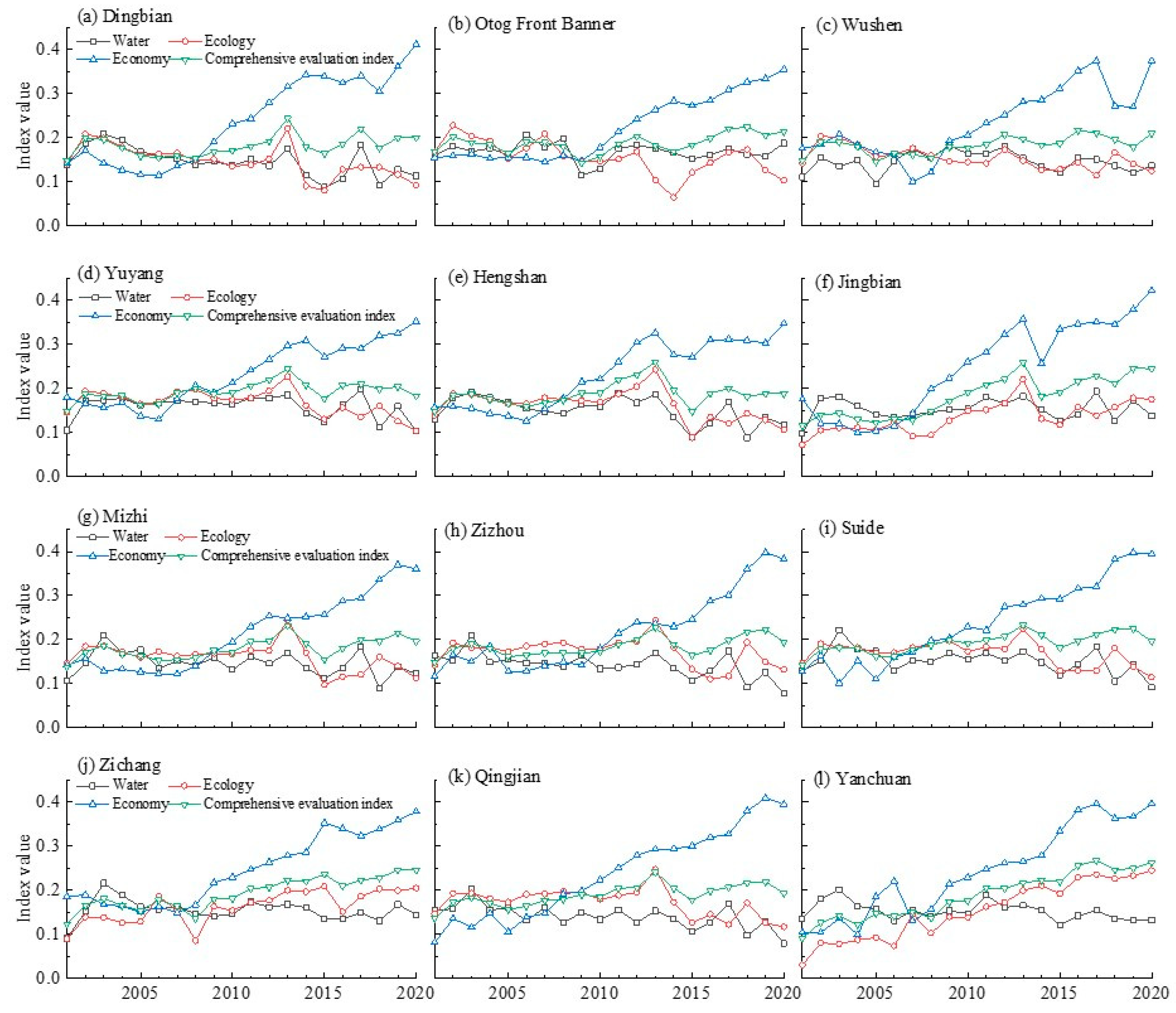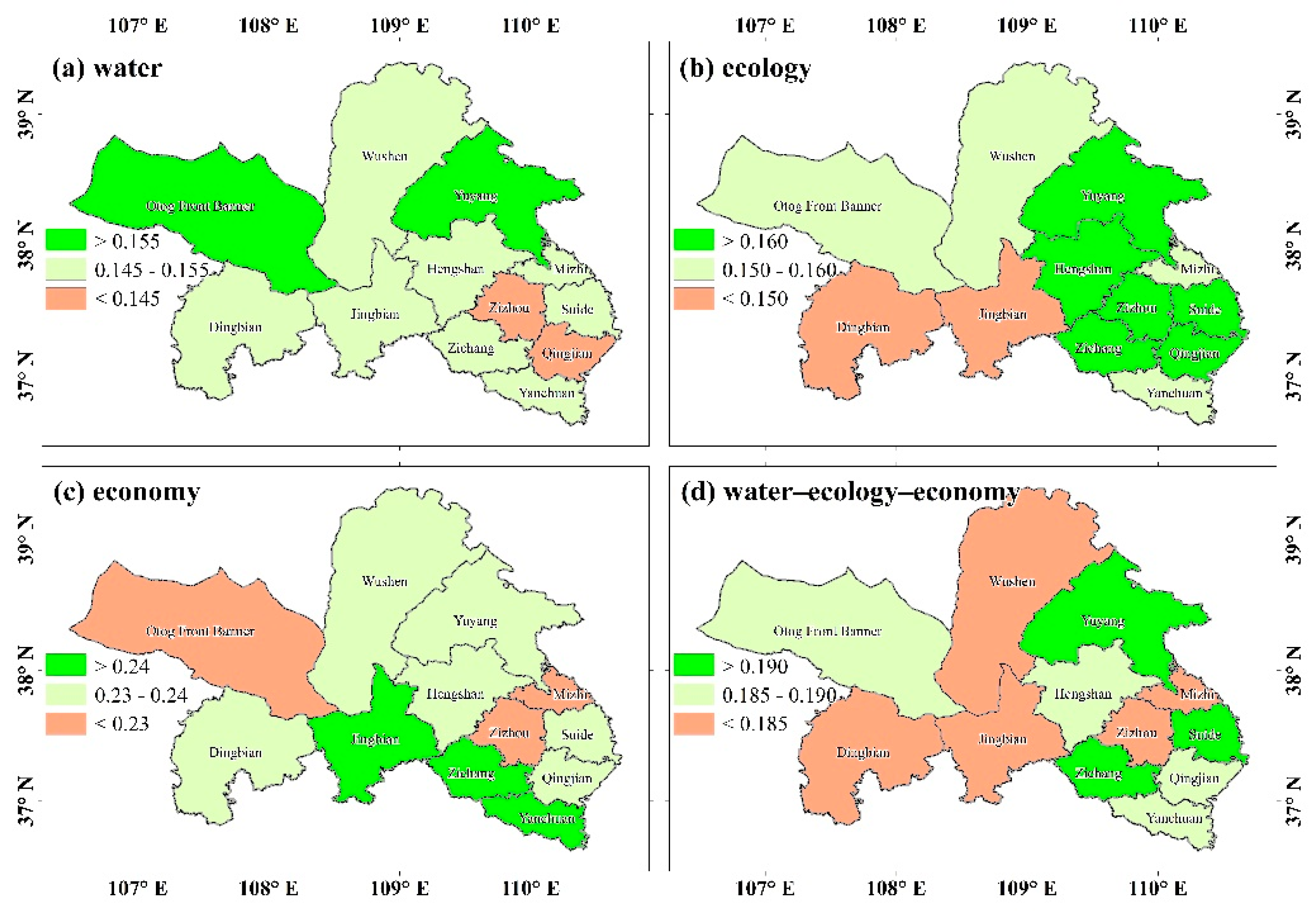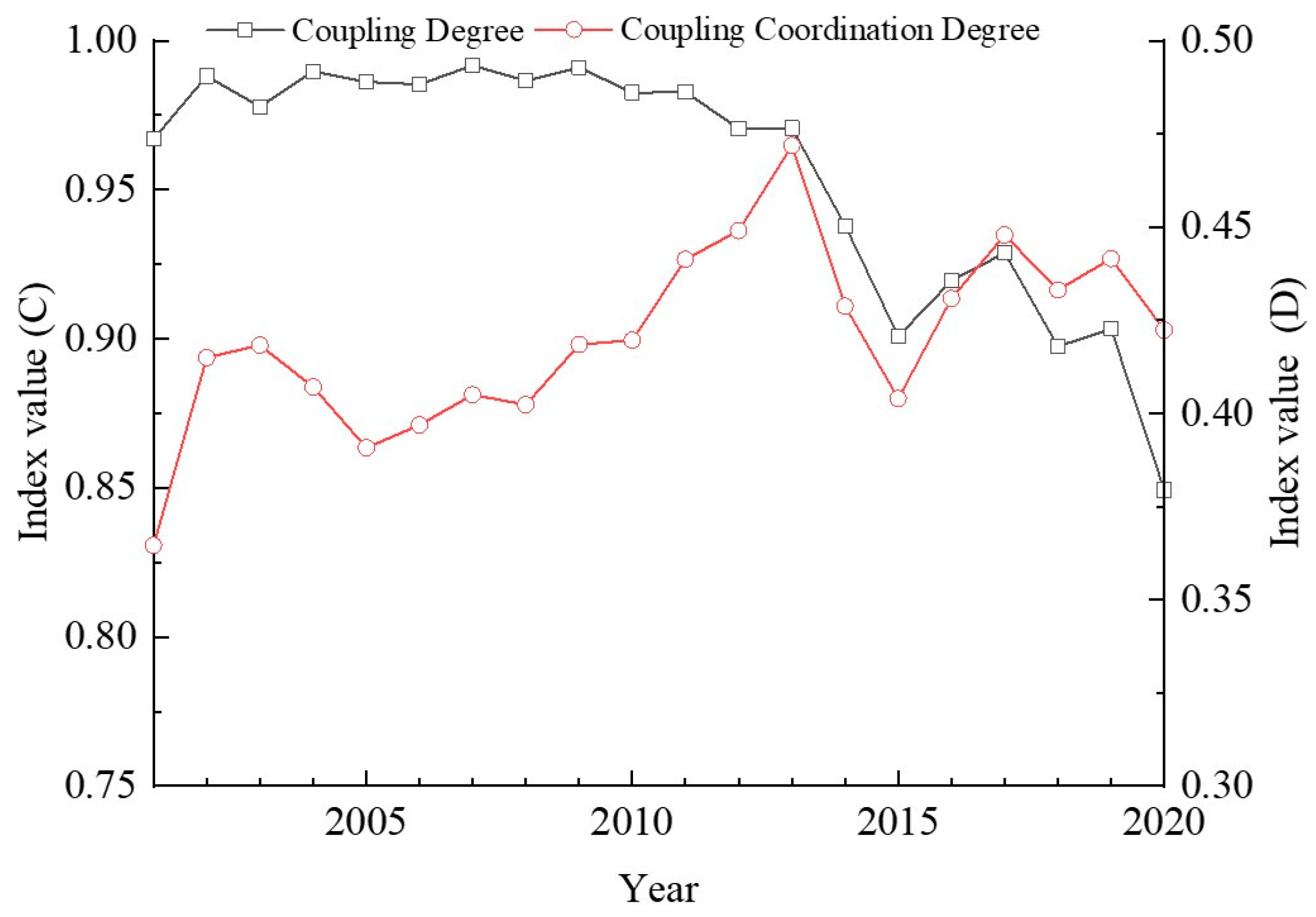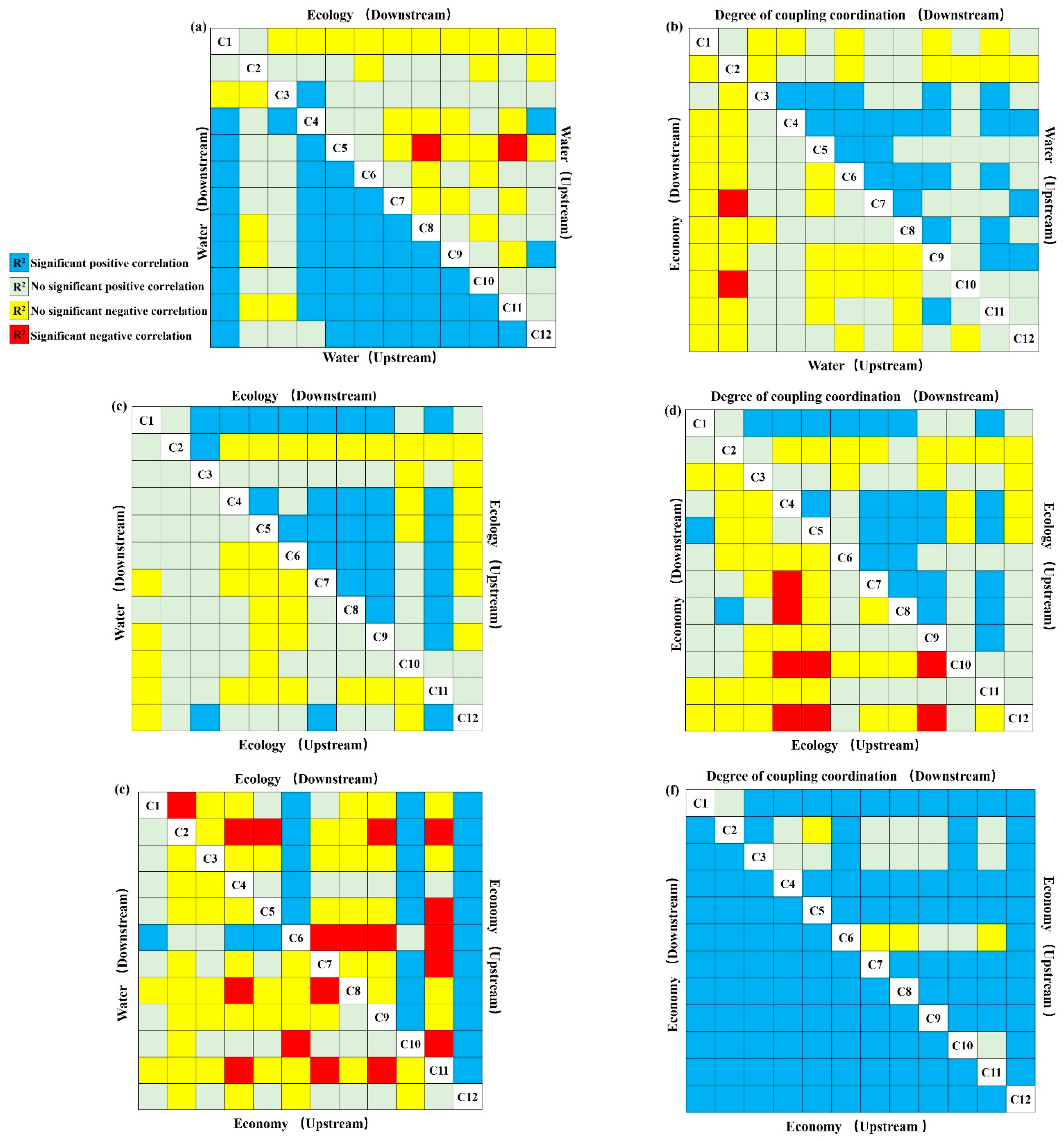Cross-County Characteristics of Water–Ecology–Economy Coupling Coordination in the Wuding River Watershed, China
Abstract
:1. Introduction
2. Materials and Methods
2.1. Study Area
2.2. Evaluation Index System and Data
2.3. Statistical Methods
2.3.1. Coupling Coordination Model
2.3.2. Grey Correlation Analysis Model
3. Results
3.1. Spatio-Temporal Patterns of Evaluation Indices of Water Resource, Ecology and Economy Subsystems and Their Comprehensive Index
3.2. Spatio-Temporal Patterns of the Coupling Degree and Coupling Coordination Degree of the Water–Ecology–Economic System
3.3. Contributions of Water, Ecology, Economy Subsystems on Their Coupling Coordination Degree
3.4. Cross-County Characteristic between Upstream and Downstream
4. Discussion
5. Conclusions
Author Contributions
Funding
Institutional Review Board Statement
Informed Consent Statement
Data Availability Statement
Conflicts of Interest
References
- Yang, G.; Wang, J.; Shao, W.; Wang, H. The Relationship Between China’s Coal Resource Development and Water Resource. Energy Procedia 2015, 75, 2548–2555. [Google Scholar] [CrossRef] [Green Version]
- Zhao, G.; Li, E.; Mu, X.; Wen, Z.; Rayburg, S.; Tian, P. Changing trends and regime shift of streamflow in the Yellow River basin. Stoch. Environ. Res. Risk Assess. 2015, 29, 1331–1343. [Google Scholar] [CrossRef]
- Vörösmarty, C.J.; McIntyre, P.B.; Gessner, M.O.; Dudgeon, D.; Prusevich, A.; Green, P.; Glidden, S.; Bunn, S.E.; Sullivan, C.A.; Liermann, C.R.; et al. Global threats to human water security and river biodiversity. Nature 2010, 467, 555–561. [Google Scholar] [CrossRef] [PubMed] [Green Version]
- McDonald, R.I.; Weber, K.; Padowski, J.; Flörke, M.; Schneider, C.; Green, P.A.; Gleeson, T.; Eckman, S.; Lehner, B.; Balk, D.; et al. Water on an urban planet: Urbanization and the reach of urban water infrastructure. Glob. Environ. Chang. 2014, 27, 96–105. [Google Scholar] [CrossRef] [Green Version]
- McDonald, R.I.; Weber, K.F.; Padowski, J.; Boucher, T.; Shemie, D. Estimating watershed degradation over the last century and its impact on water-treatment costs for the world’s large cities. Proc. Natl. Acad. Sci. USA 2016, 113, 9117–9122. [Google Scholar] [CrossRef] [PubMed] [Green Version]
- Wada, Y.; Flörke, M.; Hanasaki, N.; Eisner, S.; Fischer, G.; Tramberend, S.; Satoh, Y.; van Vliet, M.T.H.; Yillia, P.; Ringler, C.; et al. Modeling global water use for the 21st century: The Water Futures and Solutions (WFaS) initiative and its approaches. Geosci. Model Dev. 2016, 9, 175–222. [Google Scholar] [CrossRef] [Green Version]
- Gosling, S.N.; Arnell, N.W. A global assessment of the impact of climate change on water scarcity. Clim. Chang. 2016, 134, 371–385. [Google Scholar] [CrossRef] [Green Version]
- Liu, J.; Yang, H.; Gosling, S.N.; Kummu, M.; Flörke, M.; Pfister, S.; Hanasaki, N.; Wada, Y.; Zhang, X.; Zheng, C.; et al. Water scarcity assessments in the past, present, and future. Earth’s Future 2017, 5, 545–559. [Google Scholar] [CrossRef]
- Pradhan, P.; Costa, L.; Rybski, D.; Lucht, W.; Kropp, J. A Systematic Study of Sustainable Development Goal (SDG) Interactions. Earth’s Future 2017, 5, 1169–1179. [Google Scholar] [CrossRef] [Green Version]
- Best, J. Anthropogenic stresses on the world’s big rivers. Nat. Geosci. 2019, 12, 7–21. [Google Scholar] [CrossRef]
- Veldkamp, T.; Wada, Y.; Aerts, J.; Döll, P.; Gosling, S.N.; Liu, J.; Masaki, Y.; Oki, T.; Ostberg, S.; Pokhrel, Y.; et al. Water scarcity hotspots travel downstream due to human interventions in the 20th and 21st century. Nat. Commun. 2017, 8, 15697. [Google Scholar] [CrossRef] [PubMed]
- Bakker, K. Water Security: Research Challenges and Opportunities. Science 2012, 337, 914–915. [Google Scholar] [CrossRef] [PubMed]
- Ma, T.; Sun, S.; Fu, G.; Hall, J.W.; Ni, Y.; He, L.; Yi, J.; Zhao, N.; Du, Y.; Pei, T.; et al. Pollution exacerbates China’s water scarcity and its regional inequality. Nat. Commun. 2020, 11, 650. [Google Scholar] [CrossRef] [PubMed] [Green Version]
- Levin, W.E.; Unsworth, S.J. Do humans belong with nature? The influence of personal vs. abstract contexts on human–nature categorization at different stages of development. J. Environ. Psychol. 2013, 33, 9–13. [Google Scholar] [CrossRef]
- Luo, Z.; Zuo, Q.; Shao, Q.; Ding, X. The impact of socioeconomic system on the river system in a heavily disturbed basin. Sci. Total Environ. 2019, 660, 851–864. [Google Scholar] [CrossRef] [PubMed]
- Turner, S.W.D.; Rice, J.S.; Nelson, K.D.; Vernon, C.R.; McManamay, R.; Dickson, K.; Marston, L. Comparison of potential drinking water source contamination across one hundred U.S. cities. Nat. Commun. 2021, 12, 7254. [Google Scholar] [CrossRef] [PubMed]
- Chung, M.G.; Frank, K.A.; Pokhrel, Y.; Dietz, T.; Liu, J. Natural infrastructure in sustaining global urban freshwater ecosystem services. Nat. Sustain. 2021, 4, 1068–1075. [Google Scholar] [CrossRef]
- Wickham, J.D.; Wade, T.G.; Riitters, K.H. An environmental assessment of United States drinking water watersheds. Landsc. Ecol. 2011, 26, 605–616. [Google Scholar] [CrossRef] [Green Version]
- Liu, N.; Caldwell, P.V.; Dobbs, G.R.; Miniat, C.F.; Bolstad, P.V.; Nelson, S.A.C.; Sun, G. Forested lands dominate drinking water supply in the conterminous United States. Environ. Res. Lett. 2021, 16, 084008. [Google Scholar] [CrossRef]
- Carvalho, L.; Mackay, E.B.; Cardoso, A.C.; Baattrup-Pedersen, A.; Birk, S.; Blackstock, K.L.; Borics, G.; Borja, A.; Feld, C.K.; Ferreira, M.T.; et al. Protecting and restoring Europe’s waters: An analysis of the future development needs of the Water Framework Directive. Sci. Total Environ. 2019, 658, 1228–1238. [Google Scholar] [CrossRef]
- Grizzetti, B.; Liquete, C.; Pistocchi, A.; Vigiak, O.; Zulian, G.; Bouraoui, F.; De Roo, A.; Cardoso, A.C. Relationship between ecological condition and ecosystem services in European rivers, lakes and coastal waters. Sci. Total Environ. 2019, 671, 452–465. [Google Scholar] [CrossRef] [PubMed]
- Tao, S.; Fang, J.; Ma, S.; Cai, Q.; Xiong, X.; Tian, D.; Zhao, X.; Fang, L.; Zhang, H.; Zhu, J.; et al. Changes in China’s lakes: Climate and human impacts. Natl. Sci. Rev. 2019, 7, 132–140. [Google Scholar] [CrossRef] [PubMed] [Green Version]
- Lu, Z.; Wei, Y.; Xiao, H.; Zou, S.; Ren, J.; Lyle, C. Trade-offs between midstream agricultural production and downstream ecological sustainability in the Heihe River basin in the past half century. Agric. Water Manag. 2015, 152, 233–242. [Google Scholar] [CrossRef]
- Zhang, M.; Wang, S.; Fu, B.; Gao, G.; Shen, Q. Ecological effects and potential risks of the water diversion project in the Heihe River Basin. Sci. Total Environ. 2018, 619–620, 794–803. [Google Scholar] [CrossRef]
- Li, Z.; Liu, W.; Zhang, J.; Zheng, F.-L. Impacts of land use change and climate variability on hydrology in an agricultural catchment on the Loess Plateau of China. J. Hydrol. 2009, 377, 35–42. [Google Scholar] [CrossRef]
- Lu, Z.; Feng, Q.; Xiao, S.; Xie, J.; Zou, S.; Yang, Q.; Si, J. The impacts of the ecological water diversion project on the ecology-hydrology-economy nexus in the lower reaches in an inland river basin. Resour. Conserv. Recycl. 2021, 164, 105154. [Google Scholar] [CrossRef]
- Chen, Y.; Syvitski, J.P.M.; Gao, S.; Overeem, I.; Kettner, A.J. Socio-economic Impacts on Flooding: A 4000-Year History of the Yellow River, China. AMBIO 2012, 41, 682–698. [Google Scholar] [CrossRef] [Green Version]
- Li, X.; Zhong, D.; Zhang, Y.J.; Wang, Y.; Wang, Y.; Zhang, H. Wide river or narrow river: Future river training strategy for Lower Yellow River under global change. Int. J. Sediment Res. 2018, 33, 271–284. [Google Scholar] [CrossRef]
- Zhu, J.; Song, C.; Wang, J.; Ke, L. China’s inland water dynamics: The significance of water body types. Proc. Natl. Acad. Sci. USA 2020, 117, 13876–13878. [Google Scholar] [CrossRef]
- Wu, X.; Wei, Y.; Fu, B.; Wang, S.; Zhao, Y.; Moran, E.F. Evolution and effects of the social-ecological system over a millennium in China’s Loess Plateau. Sci. Adv. 2020, 6, eabc0276. [Google Scholar]
- Han, J.; Gao, J.; Luo, H. Changes and implications of the relationship between rainfall, runoff and sediment load in the Wuding River basin on the Chinese Loess Plateau. CATENA 2019, 175, 228–235. [Google Scholar] [CrossRef]
- Xu, J.-X.; Ji, S. Effect of erosion control measures on sediment delivery ratio. Adv. Water Sci. 2004, 15, 29. [Google Scholar]
- Dang, C.; Zhang, H.; Singh, V.P.; Yu, Y.; Shao, S. Investigating Hydrological Variability in the Wuding River Basin: Implications for Water Resources Management under the Water–Human-Coupled Environment. Water 2021, 13, 184. [Google Scholar] [CrossRef]
- Fu, B.J.; Wu, B.F.; Lue, Y.H.; Xu, Z.H.; Cao, J.H.; Niu, D.; Yang, G.S.; Zhou, Y.M. Three Gorges Project: Efforts and challenges for the environment. Prog. Phys. Geogr. Earth Environ. 2010, 34, 741–754. [Google Scholar] [CrossRef]
- Tang, Y.; Liu, S.; Li, X.; Fan, Y.; Deng, Y.; Liu, Y.; Yin, L. Earthquakes spatio–temporal distribution and fractal analysis in the Eurasian seismic belt. Rend. Lincei. Sci. Fis. E Naturali. 2020, 31, 203–209. [Google Scholar] [CrossRef]
- Chen, Z.; Liu, Z.; Yin, L.; Zheng, W. Statistical analysis of regional air temperature characteristics before and after dam construction. Urban Clim. 2022, 41, 101085. [Google Scholar] [CrossRef]
- Jiongxin, X.U. Sediment Flux to the Sea as Influenced by Changing Human Activities and Precipitation: Example of the Yellow River, China. Environ. Manag. 2003, 31, 0328–0341. [Google Scholar] [CrossRef]
- Huang, M.; Zhang, L. Hydrological responses to conservation practices in a catchment of the Loess Plateau, China. Hydrol. Process. 2004, 18, 1885–1898. [Google Scholar] [CrossRef]
- Mu, X.; Zhang, L.; McVicar, T.R.; Chille, B.; Gau, P. Analysis of the impact of conservation measures on stream flow regime in catchments of the Loess Plateau, China. Hydrol. Process. 2007, 21, 2124–2134. [Google Scholar] [CrossRef]
- Zhou, Y.; Shi, C.; Du, J.; Fan, X. Characteristics and causes of changes in annual runoff of the Wuding River in 1956–2009. Environ. Earth Sci. 2013, 69, 225–234. [Google Scholar] [CrossRef]
- Liang, W.; Bai, D.; Jin, Z.; You, Y.; Li, J.; Yang, Y. A Study on the Streamflow Change and its Relationship with Climate Change and Ecological Restoration Measures in a Sediment Concentrated Region in the Loess Plateau, China. Water Resour. Manag. 2015, 29, 4045–4060. [Google Scholar] [CrossRef]
- Zhang, K.; Ali, A.; Antonarakis, A.; Moghaddam, M.; Saatchi, S.; Tabatabaeenejad, A.; Chen, R.; Jaruwatanadilok, S.; Cuenca, R.; Crow, W.T.; et al. The Sensitivity of North American Terrestrial Carbon Fluxes to Spatial and Temporal Variation in Soil Moisture: An Analysis Using Radar-Derived Estimates of Root-Zone Soil Moisture. J. Geophys. Res. Biogeosci. 2019, 124, 3208–3231. [Google Scholar] [CrossRef]
- Longo, M.; Knox, R.G.; Medvigy, D.M.; Levine, N.M.; Dietze, M.C.; Kim, Y.; Swann, A.L.S.; Zhang, K.; Rollinson, C.R.; Bras, R.L.; et al. The biophysics, ecology, and biogeochemistry of functionally diverse, vertically and horizontally heterogeneous ecosystems: The Ecosystem Demography model, version 2.2–Part 1: Model description. Geosci. Model Dev. 2019, 12, 4309–4346. [Google Scholar] [CrossRef] [Green Version]
- Li, E.; Mu, X.; Zhao, G.; Gao, P.; Sun, W. Effects of check dams on runoff and sediment load in a semi-arid river basin of the Yellow River. Stoch. Environ. Res. Risk Assess. 2017, 31, 1791–1803. [Google Scholar] [CrossRef]
- Liu, Y.; Zhang, K.; Li, Z.; Liu, Z.; Wang, J.; Huang, P. A hybrid runoff generation modelling framework based on spatial combination of three runoff generation schemes for semi-humid and semi-arid watersheds. J. Hydrol. 2020, 590, 125440. [Google Scholar] [CrossRef]
- Hutchinson, M.F. Interpolating mean rainfall using thin plate smoothing splines. Int. J. Geogr. Inf. Syst. 1995, 9, 385–403. [Google Scholar] [CrossRef]
- Save, H.; Bettadpur, S.; Tapley, B.D. High-resolution CSR GRACE RL05 mascons. J. Geophys. Res. Solid Earth 2016, 121, 7547–7569. [Google Scholar] [CrossRef]
- Zhao, M.; Heinsch, F.A.; Nemani, R.R.; Running, S.W. Improvements of the MODIS terrestrial gross and net primary production global data set. Remote Sens. Environ. 2005, 95, 164–176. [Google Scholar] [CrossRef]
- Yan, K.; Park, T.; Yan, G.; Liu, Z.; Yang, B.; Chen, C.; Nemani, R.R.; Knyazikhin, Y.; Myneni, R.B. Evaluation of MODIS LAI/FPAR Product Collection 6. Part 1: Consistency and Improvements. Remote Sens. 2016, 8, 359. [Google Scholar] [CrossRef] [Green Version]
- Mu, Q.; Zhao, M.; Running, S.W. Improvements to a MODIS global terrestrial evapotranspiration algorithm. Remote Sens. Environ. 2011, 115, 1781–1800. [Google Scholar] [CrossRef]
- Liu, Y.; Yao, C.; Wang, G.; Bao, S. An integrated sustainable development approach to modeling the eco-environmental effects from urbanization. Ecol. Indic. 2011, 11, 1599–1608. [Google Scholar] [CrossRef]
- Li, Y.; Li, Y.; Zhou, Y.; Shi, Y.; Zhu, X. Investigation of a coupling model of coordination between urbanization and the environment. J. Environ. Manag. 2012, 98, 127–133. [Google Scholar] [CrossRef] [PubMed]
- Zhang, H.; Gu, C.-L.; Gu, L.-W.; Zhang, Y. The evaluation of tourism destination competitiveness by TOPSIS & information entropy—A case in the Yangtze River Delta of China. Tour. Manag. 2011, 32, 443–451. [Google Scholar]
- Xie, N.; Liu, S. Research on evaluations of several grey relational models adapt to grey relational axioms. J. Syst. Eng. Electron. 2009, 20, 304–309. [Google Scholar]
- Liao, S.; Wu, Y.; Wong, S.W.; Shen, L. Provincial perspective analysis on the coordination between urbanization growth and resource environment carrying capacity (RECC) in China. Sci. Total Environ. 2020, 730, 138964. [Google Scholar] [CrossRef]
- Fan, Y.; Fang, C.; Zhang, Q. Coupling coordinated development between social economy and ecological environment in Chinese provincial capital cities-assessment and policy implications. J. Clean. Prod. 2019, 229, 289–298. [Google Scholar] [CrossRef]
- Wang, S.; Li, R. Toward the Coordinated Sustainable Development of Urban Water Resource Use and Economic Growth: An Empirical Analysis of Tianjin City, China. Sustainability 2018, 10, 1323. [Google Scholar] [CrossRef] [Green Version]
- Bao, C.; He, D. The Causal Relationship between Urbanization, Economic Growth and Water Use Change in Provincial China. Sustainability 2015, 7, 16076–16085. [Google Scholar] [CrossRef] [Green Version]
- Di Baldassarre, G.; Sivapalan, M.; Rusca, M.; Cudennec, C.; Garcia, M.; Kreibich, H.; Konar, M.; Mondino, E.; Mård, J.; Pande, S.; et al. Sociohydrology: Scientific Challenges in Addressing the Sustainable Development Goals. Water Resour. Res. 2019, 55, 6327–6355. [Google Scholar] [CrossRef] [Green Version]
- Zheng, M. Scale Independence and Spatial Uniformity of Specific Sediment Yield in Loess Areas of the Wuding River Basin, Northwest China. Land Degrad. Dev. 2017, 28, 1450–1462. [Google Scholar] [CrossRef]
- Liu, S.; Mo, X.; Zhao, W.; Naeimi, V.; Dai, D.; Shu, C.; Mao, L. Temporal variation of soil moisture over the Wuding River basin assessed with an eco-hydrological model, in-situ observations and remote sensing. Hydrol. Earth Syst. Sci. 2009, 13, 1375–1398. [Google Scholar] [CrossRef] [Green Version]
- Feng, Y.; Chiu, Y.-H.; Liu, F.-P. Measuring the Performance of Wastewater Treatment in China. Appl. Sci. 2019, 9, 153. [Google Scholar] [CrossRef] [Green Version]
- Li, P.; Mu, X.; Holden, J.; Wu, Y.; Irvine, B.; Wang, F.; Gao, P.; Zhao, G.; Sun, W. Comparison of soil erosion models used to study the Chinese Loess Plateau. Earth-Sci. Rev. 2017, 170, 17–30. [Google Scholar] [CrossRef] [Green Version]
- Wang, Y.; Geng, Q.; Si, X.; Kan, L. Coupling and coordination analysis of urbanization, economy and environment of Shandong Province, China. Environ. Dev. Sustain. 2021, 23, 10397–10415. [Google Scholar] [CrossRef]
- Yao, L.; Li, X.; Li, Q.; Wang, J. Temporal and Spatial Changes in Coupling and Coordinating Degree of New Urbanization and Ecological-Environmental Stress in China. Sustainability 2019, 11, 1171. [Google Scholar] [CrossRef] [Green Version]
- Merz, L.; Yang, D.; Hull, V. A Metacoupling Framework for Exploring Transboundary Watershed Management. Sustainability 2020, 12, 1879. [Google Scholar] [CrossRef] [Green Version]
- Jenerette, G.D.; Larsen, L. A global perspective on changing sustainable urban water supplies. Glob. Planet. Chang. 2006, 50, 202–211. [Google Scholar] [CrossRef]
- Jia, R.; Jiang, X.; Shang, X.; Wei, C. Study on the Water Resource Carrying Capacity in the Middle Reaches of the Heihe River Based on Water Resource Allocation. Water 2018, 10, 1203. [Google Scholar] [CrossRef] [Green Version]
- Weidner, H. Capacity-Building for Ecological Modernization: Lessons From Cross-National Research. Am. Behav. Sci. 2002, 45, 1340–1368. [Google Scholar] [CrossRef]
- Chakraborty, K. Integrated Water Resources Management: Global Theory, Emerging Practice, and Local Needs. Am. J. Agric. Econ. 2008, 90, 856–857. [Google Scholar] [CrossRef]
- Underdal, A. Complexity and challenges of long-term environmental governance. Globl Environ. Chang. Guildf. 2010, 20, 386–393. [Google Scholar] [CrossRef]
- Tsang, S.; Burnett, M.; Hills, P.; Welford, R. Trust, public participation and environmental governance in Hong Kong. Environ. Policy Gov. 2009, 19, 99–114. [Google Scholar] [CrossRef]
- Eckerberg, K.; Joas, M. Multi-level Environmental Governance: A concept under stress? Local Environ. 2004, 9, 405–412. [Google Scholar] [CrossRef]
- Prokopy, L.S.; Mullendore, N.; Brasier, K.; Floress, K. A Typology of Catalyst Events for Collaborative Watershed Management in the United States. Soc. Nat. Resour. 2014, 27, 1177–1191. [Google Scholar] [CrossRef]
- Guan, X.; Liu, W.; Chen, M. Study on the ecological compensation standard for river basin water environment based on total pollutants control. Ecol. Indic. 2016, 69, 446–452. [Google Scholar] [CrossRef]
- Guo, H.; Chen, X.; Liu, J.; Zhang, H.; Svensson, J. Joint analysis of water rights trading and water-saving management contracts in China. Int. J. Water Resour. Dev. 2020, 36, 716–737. [Google Scholar] [CrossRef]








| Target Layer | Guideline Layer | Index Layer | Unit | Data Sources | Property 1 | Weight |
|---|---|---|---|---|---|---|
| Water | Water resource situation | Annual total precipitation | mm | China Meteorological Data Network | + | 0.033 |
| Surface water storage | 108 m3 | Statistical yearbook NASA CSR GRACE data | + | 0.043 | ||
| Groundwater storage | cm | + | 0.065 | |||
| Water resource utilization | Water consumption per capita | m3 | Statistical yearbook | - | 0.051 | |
| Water consumption per million yuan | m3 | - | 0.030 | |||
| Domestic water | 108 m3 | - | 0.046 | |||
| Ecology | Ecosystem function | Net primary productivity | kgC m−2 year−1 | NASA MODIS data | + | 0.045 |
| Water conservation capacity | m3 m−2 year−1 | + | 0.033 | |||
| Vegetation leaf area | m2 m−2 | + | 0.045 | |||
| Pollutant emission | Wastewater emission | 104 t | Statistical yearbook | - | 0.039 | |
| Solid waste emission | 104 t | - | 0.051 | |||
| Waste gas emission | 108 t | - | 0.056 | |||
| Economy | Economic and social situation | Gross domestic product per capita | Yuan | Statistical yearbook | + | 0.098 |
| Fixed investment per capita | Yuan | + | 0.116 | |||
| Disposable income | Yuan | + | 0.079 | |||
| Industrial structure | Proportion of primary industry | % | Statistical yearbook | + | 0.117 | |
| Proportion of secondary industry | % | + | 0.055 | |||
| Proportion of tertiary industry | % | + | 0.069 |
| Type | Coupling Coordination Degree | Category |
|---|---|---|
| Coordinated development | 0.90–1.00 | High-quality coordinated development |
| 0.80–0.89 | Good coordinated development | |
| 0.70–0.79 | Intermediate coordinated development | |
| 0.60–0.69 | Primary coordinated development | |
| Excessive status | 0.50–0.59 | Barely coordinated development |
| 0.40–0.49 | On the verge of dysfunctional decline | |
| Dysfunctional decline | 0.30–0.39 | Mild dysfunctional decline |
| 0.20–0.29 | Moderate dysfunctional decline | |
| 0.10–0.19 | Severe dysfunctional decline | |
| 0–0.09 | Extremely dysfunctional decline |
Publisher’s Note: MDPI stays neutral with regard to jurisdictional claims in published maps and institutional affiliations. |
© 2022 by the authors. Licensee MDPI, Basel, Switzerland. This article is an open access article distributed under the terms and conditions of the Creative Commons Attribution (CC BY) license (https://creativecommons.org/licenses/by/4.0/).
Share and Cite
Tao, J.; Xie, Y.; Zhou, H.; Xu, Y.; Zhao, G. Cross-County Characteristics of Water–Ecology–Economy Coupling Coordination in the Wuding River Watershed, China. Land 2022, 11, 2283. https://doi.org/10.3390/land11122283
Tao J, Xie Y, Zhou H, Xu Y, Zhao G. Cross-County Characteristics of Water–Ecology–Economy Coupling Coordination in the Wuding River Watershed, China. Land. 2022; 11(12):2283. https://doi.org/10.3390/land11122283
Chicago/Turabian StyleTao, Jian, Yujie Xie, Haoyuan Zhou, Yuqian Xu, and Guangshuai Zhao. 2022. "Cross-County Characteristics of Water–Ecology–Economy Coupling Coordination in the Wuding River Watershed, China" Land 11, no. 12: 2283. https://doi.org/10.3390/land11122283







